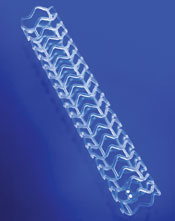Bioresorbable vascular scaffold offers innovative new treatment for CAD
A new device that performs similarly to a stent without leaving an implant has entered into a larger phase of clinical trials, although it is not yet available for sale.
The bioresorbable vascular scaffold (BVS, Abbott) is made of polylactide and is designed to restore blood flow to the heart by providing additional support to hold the vessel open while delivering everolimus to inhibit vessel renarrowing. Once the vessel heals, the BVS is metabolized by the body and fully absorbed. The vessel is then returned to a more natural state and is able to move, expand, contract and flex as an untreated vessel.
“We expect the BVS to free up the vessel mechanically after it resorbs away, so the vessel will not be permanently caged in a metal tube. This way, it can respond to cardiac demand, expand and heal under cyclic load of BP, very much in the way bones heal,” Richard Rapoza, PhD, divisional vice president of research and development in charge for the BVS program at Abbott Vascular, told Cardiology Today. “We expect that, like bones, arteries also need this normal cyclic load to heal correctly. The BVS will enable that for the first time.”
According to Patrick W. Serruys, MD, PhD, professor of interventional cardiology at the Thoraxcentre, Erasmus University Hospital, Rotterdam, the Netherlands, treatment with the BVS may also minimize irritation to the vessel wall and potentially reduce the need for long-term dual antiplatelet therapy. “Additionally, more treatment options are viable if re-intervention is required in the future as the vessel is unobstructed,” he said in an interview.
|
Source: Abbott |
“When we had our first case in Europe, the physician was surprised with how much attention BVS received, especially when framing it from the standpoint that it didn’t seem like anything had changed in the way that he used the device, how it felt like inside the body and how it worked,” Rapoza said. “From the beginning, we were looking for a device that is exactly like what doctors use now but that completely changes the way the product performs inside the body.”
Recent data from the ABSORB trial, Serruys said, show that the BVS has the potential to change how physicians treat patients with CAD. “At the EuroPCR 2010 meeting, we saw that the 6-month late loss rate was 0.19 mm, which is comparable or better than what we’ve seen with many of the widely used metallic drug-eluting stents currently on the market. This finding is remarkable because it suggests that the BVS can treat a clogged vessel as effectively as a stent, but offers the added benefit of not leaving a permanent implant behind after the vessel is healed.”
Based on the trial results seen thus far, which include a 4.4% occurrence of major adverse coronary events, Serruys said, “I am optimistic that the BVS could become the next standard of care for treating CAD.” – by Brian Ellis
Update: On January 10, 2011, Abbott announced that its BVS received CE Mark approval in Europe.

